A Private Tour today down in the Brecks, but with a difference. We had a specific list of target species, which meant we would aim to spend the morning in the Brecks themselves and the afternoon at Lakenheath Fen and the surrounding area. After a frosty night, it was a lovely bright, clear, sunny day, but cold in the still blustery NE wind.
After an earlier than normal start, we headed out to look for Stone Curlews first. A few early birds have already arrived back and presumably must be regretting it! It had snowed a little yesterday and the fields were covered in a light dusting of snow this morning.
The first field we checked, where we had seen them a couple of days ago, was empty today, apart from a couple of Red-legged Partridges. We checked out the other field they favour and at first it appeared devoid of life too until somebody noticed two shapes huddled up tight against the hedge – the Stone Curlews. They were clearly trying to get out of the cold wind, despite the fact they were up to their knees in snow!
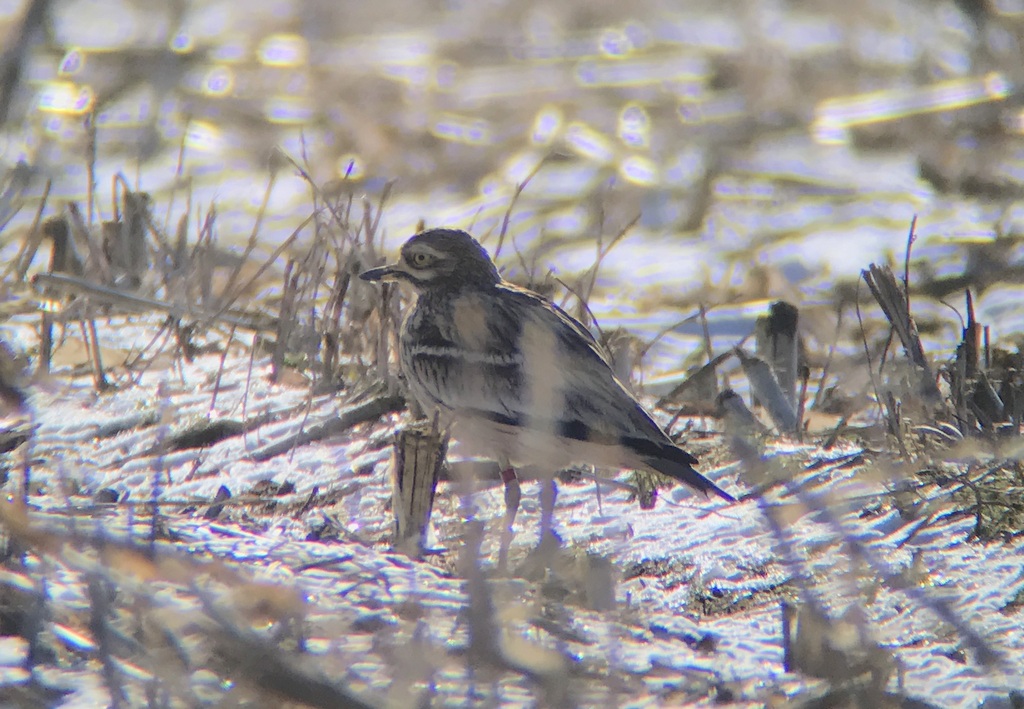
The Stone Curlews walked out a short distance into the field, where we had a very good look at them through the scope, before they headed back in to the shelter of the hedge once more. Further over, out in the middle of the field, a pair of Grey Partridge were trying to hide in one of the wheel ruts.
Goshawk was another target for the day, but it was still a bit cold for them to be up. We drove round via a good site for them but a quick scan from the warmth of the car revealed very little aerial activity. There were several Fieldfares feeding on the ground out in the field nearby, along with a couple of Mistle Thrush and a few Chaffinches. We would come back later, when it had warmed up a little (relatively speaking!). In the meantime, we headed off to look for Woodlarks.
As we walked along the ride past the first clearing, there was quite a bit of snow covering the ground. It didn’t look especially promising. The second clearing we looked in was even worse. There is some farmland just beyond the forest here, and we figured they might have moved out to the fields to look for food, so we headed over that way.
As we walked past the third clearing towards the fields, we heard a Woodlark call and looked across to see two come up off the bare ground beyond. They flew over towards us and did a circuit of the clearing, calling to each other. The male twittered, but never really broke into full song. While one of them flew quickly back to the fields, the male Woodlark landed in the top of a small oak tree on the edge of the clearing, where he did start to sing rather half-heartedly.
We walked round to the oak tree for a closer look and got the Woodlark in the scope, getting a good look at it before he took off and flew away over the clearing and dropped down again onto the field beyond. Satisfied with what we had seen, we turned to go but we hadn’t got very far before a pair of Woodlarks flew in calling again. They circled round and landed only a short distance away from us, in a small patch in the clearing which was relatively free of lying snow.
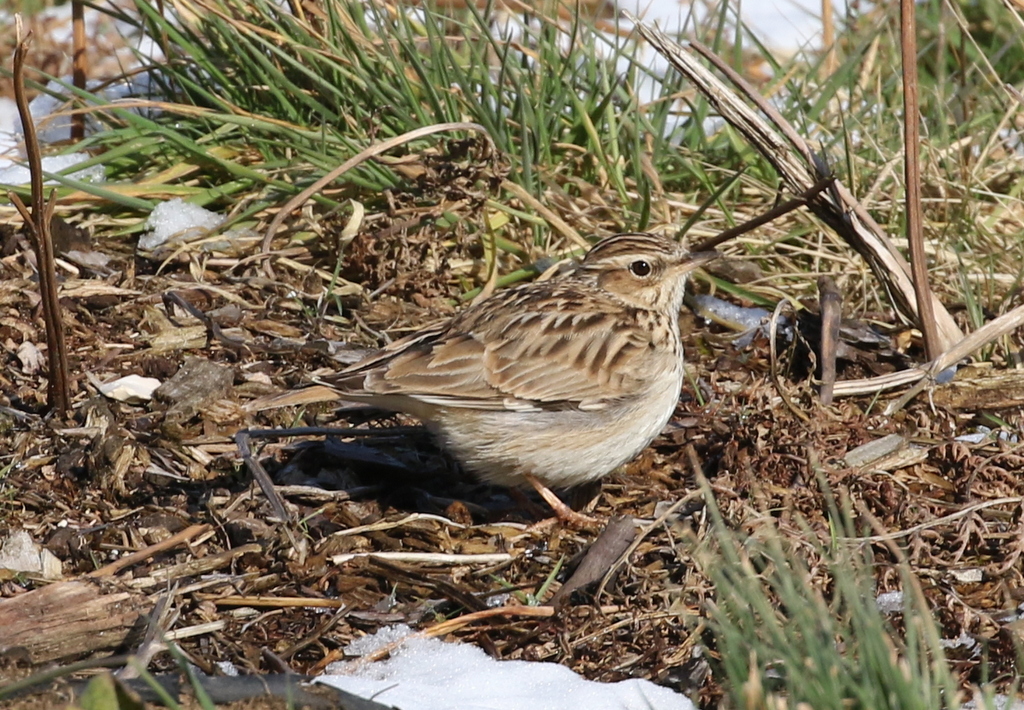
As we walked back to the car, it was still very cold in the wind but it felt like the sun was starting to get a bit more warmth to it, so we headed off to look for Goshawks. We hadn’t been there long before the first Common Buzzards started to appear, first one or two, then a group of three circled up behind.
Not too long afterwards, a Goshawk circled up too. It was rather distant, but through the scope we could see it was an adult, pale grey above and bright whitish below, a male by the looks of things. It didn’t gain much height as it circled, drifting slowly across and eventually dropping back down behind the trees. It wasn’t the best view, but at least we had seen a Goshawk. It was rather cold here standing out in the open, so we decided to head off and look for something else.
Willow Tit was the next species on the list. We drove round to a spot where some feeding tables have been set up in the hope of tempting them in. As we walked up the ride, a Redwing appeared in the trees by the path.
The feeding tables were well stocked with sunflower seeds and a steady stream of Blue Tits, Great Tits and Coal Tits were coming in to take advantage, or flitting around in the pines nearby. A Marsh Tit appeared in the trees by the path – a bit too plain and grey compared to the one we were hoping for. We had nice views of a Nuthatch climbing down a tree trunk here too.

We didn’t have to wait long before we heard a Willow Tit, a male singing deep in the plantation behind one the feeders. For a minute or so, it sang repeatedly, a series of loud, ringing ‘tseeooo’ notes, and it seemed like it might be working its way towards us. Then it went quiet. We scanned the edge of the trees in case it came out but about ten minutes later, we got two more ‘tseeooo’s from about the same place, and that was it.
It gradually became clear that was all we were going to get for a while. We were about to leave when we looked up and saw a raptor circling low over the trees – a Goshawk. It disappeared back over the trees but a couple of minutes later, we saw it fly across the ride further up, closely followed be a second Goshawk. We thought there was a good chance they might start to display, so we walked up to a spot where there was an opening in the trees.
When we got there, we could see one of the two Goshawks still up above the pines. It was hanging in the wind, not really displaying, but with its white undertail coverts puffed out. It was a much better view than the distant one we had seen earlier. It gradually drifted away and dropped down behind the trees again.
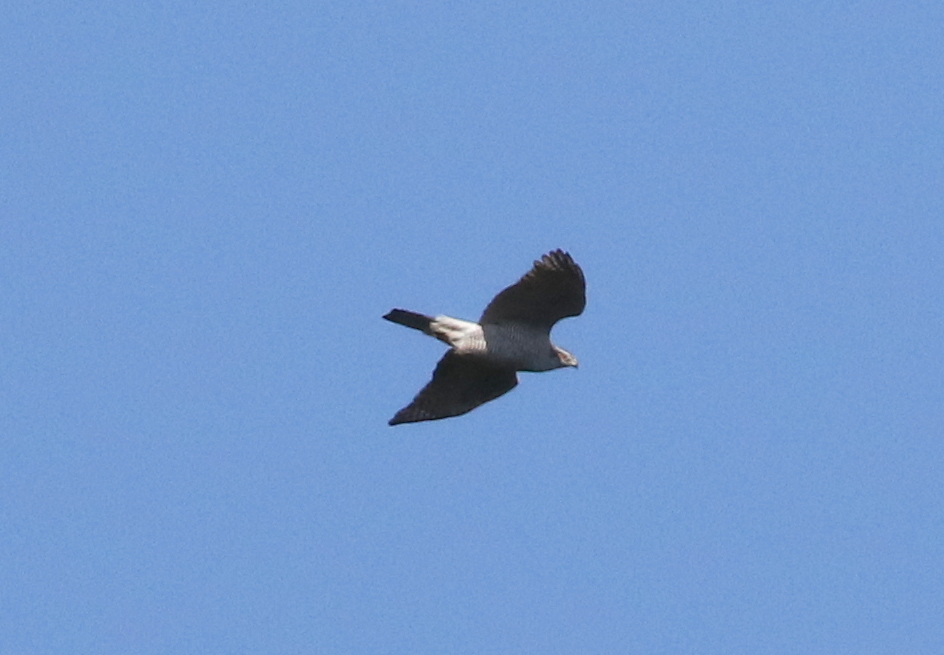
As we walked back, the two Goshawks appeared again, high over the ride. The male was displaying now, way up in the sky, flying with deep, exaggerated wingbeats, while the larger female circled below.
Apart from actually seeing a Willow Tit, we had found all our Brecks targets already, and had very good views of all the rest of them. We decided to head off and try something different – we could always swing back round here on our way back later.
Common Crane was next on the list, which meant a drive over into the edge of the Fens. We had a look round several of the places they like to feed and, after stopping to check through various Greylag and Canada Geese off in the distance, we spotted a lone Common Crane flying over the meadows. It dropped down behind an area of thick rushes, where it started to feed.
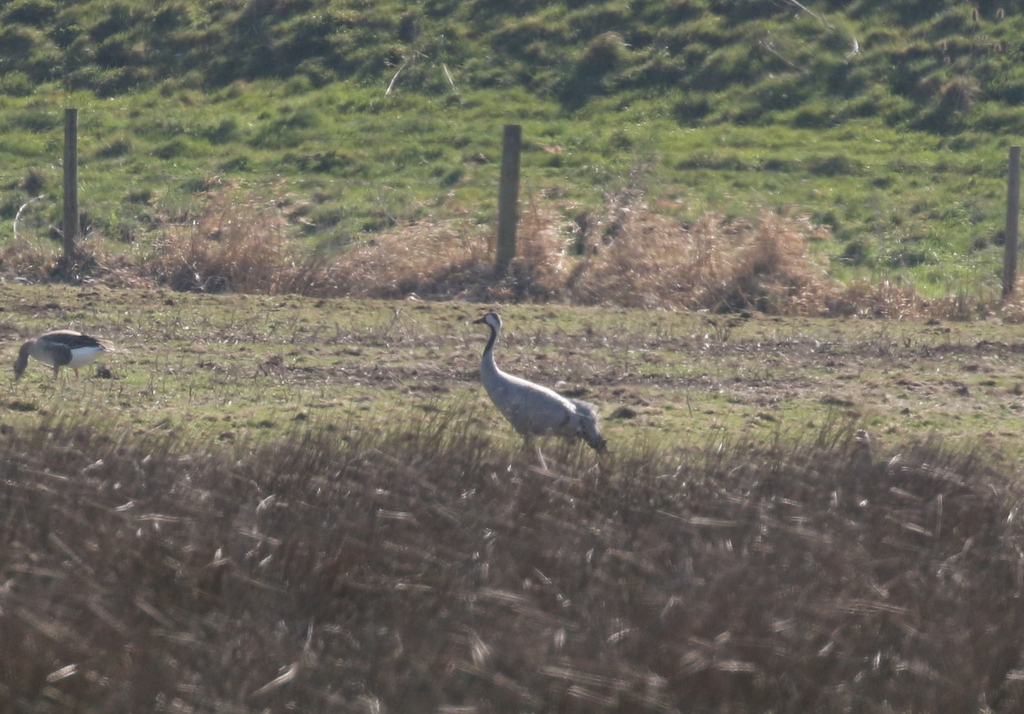
There is usually a pair of Common Cranes here and they are rarely seen apart, so hopefully the fact that it was on its own may suggest that this pair are getting down to breeding already.
It was getting on to lunchtime now, so we made our way round to Lakenheath Fen next, where we stopped for a bite to eat. After lunch, we headed out towards the Washland viewpoint. There were lots of Reed Buntings around the feeders outside the visitor centre.

As we walked up onto the river bank at the Washland, the first bird we saw was a Great White Egret, a short distance away to the east along the river. Just behind it, a swan on the edge of the reeds turned out to be a lone Whooper Swan. They are not often on their own here and this one didn’t look entirely well, so perhaps it had been unable to follow the rest of the Whooper Swans back towards Iceland.
There were lots of ducks out on the Washland too, mainly Shoveler, Wigeon and Shelduck. A couple of small parties of Tufted Duck were down on the river, along with a few Teal.
The bird we had really hoped to see here was Water Pipit. There are usually quite a few along the river here, but they can be horribly elusive. Today, however, our luck was in as we quickly spotted one picking around one of the islands of rushes just below the viewpoint. It appeared to be in moult, gradually losing its streaked underparts before gaining the brighter pink breast of summer plumage.

Spoonbill is an unusual bird down here – much commoner up on the coast – so it was not one we had predicted as a possible today. However, following news that one was here yesterday, we had learnt at the visitor centre that it was still present today, along the river. We hadn’t ventured far from the Washland viewpoint, when we spotted a large white shape further downstream, feeding along the far bank. Through the scope, we could confirm it was the Spoonbill.
We walked up the bank until we were roughly opposite the Spoonbill and had a good look at it. We could see the yellow tip to its spoon-shaped bill, the mustard wash across its breast and a flowing crest blowing around in the wind, suggesting it was an adult.
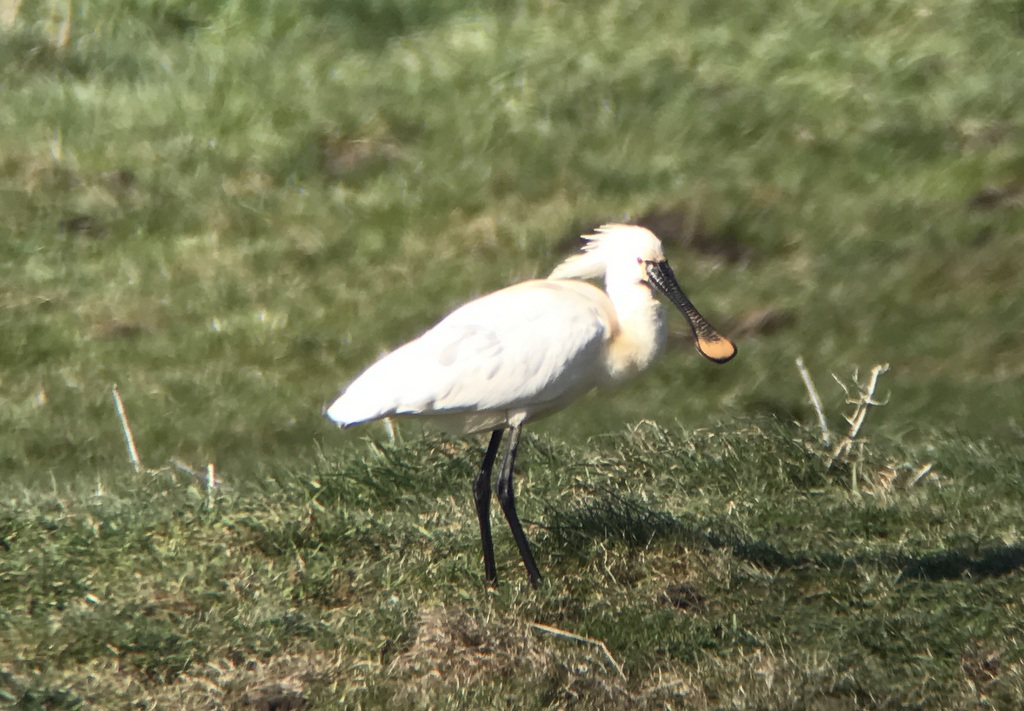
We were now opposite New Fen, so we cut back in onto the reserve. A pair of Gadwall and a couple of Little Grebe were the only new birds here. With out targets achieved so quickly, we decided not to walk out around the rest of the reserve and made our way back to the visitor centre.
Willow Tit was the only one of the species we had set out to see today which still eluded us, so we decided to head back over for one more go, on our way back to where we had started the day. When we arrived, we met a couple of people leaving who told us that it had just been singing and calling pretty constantly, but remained rather elusive.
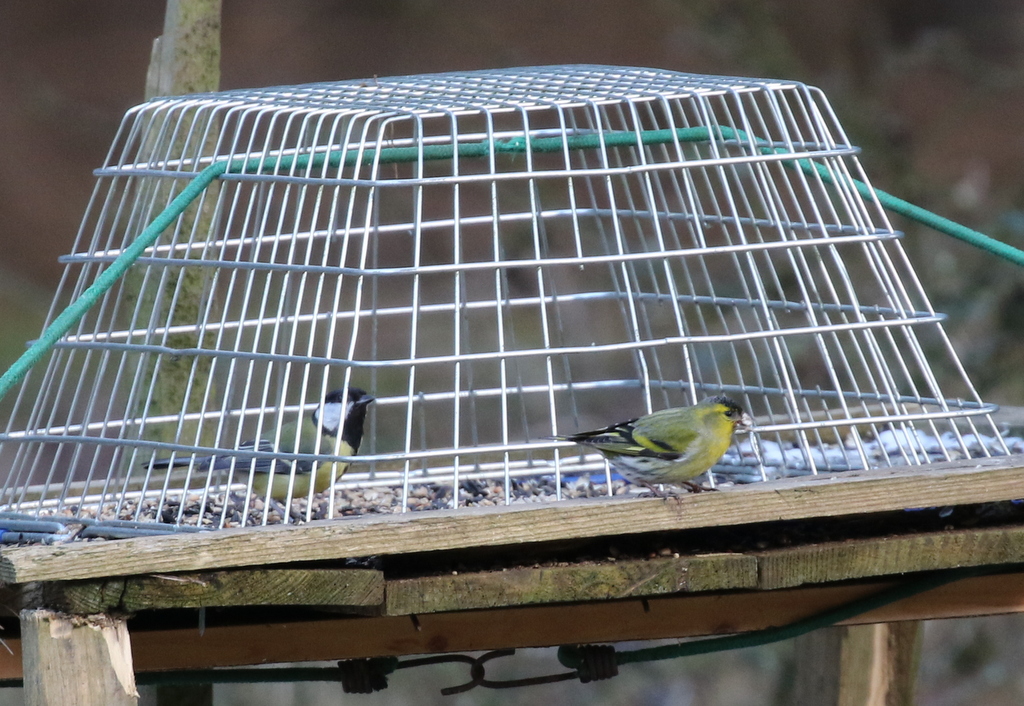
We walked back up to the feeding stations, where a smart male Siskin had joined the tits down on the sunflower seeds. We stood and watched the comings and goings for a while, but it started to seem like we might be out of luck. Then we heard a Willow Tit calling in the plantation on the other side of the ride, a deep, nasal scolding. Once again, it sounded like it might be heading our way, so we stood and scanned the edge of the trees.
This time the Willow Tit did come out, but it flew from the tops of the pines of one side of the ride, right over our heads. It appeared to be dropping down towards one of the feeding tables, but then seemed to go down into the bushes beyond. We focused on the feeding table, expecting it to make a visit there, but we didn’t see it. The next thing we knew, it started singing from the pines behind.
The Willow Tit was not far into the plantation this time, so we followed the song and found ourselves standing below the tree where it was. It sang and sang for about 10 minutes, but even though we knew exactly which tree it was in, it was almost impossible to see. It was high in the top and not moving. Eventually, it started to move and we get a quick look at it when it came to the outer branches of the tree, before moving off and going quiet.
Perhaps not the best view ever of a Willow Tit, but at least we had seen it now. It meant we had completed the set, all the target species we had set out to find today. With long journeys back and after our early start, we decided to call it a day and head for home.
















